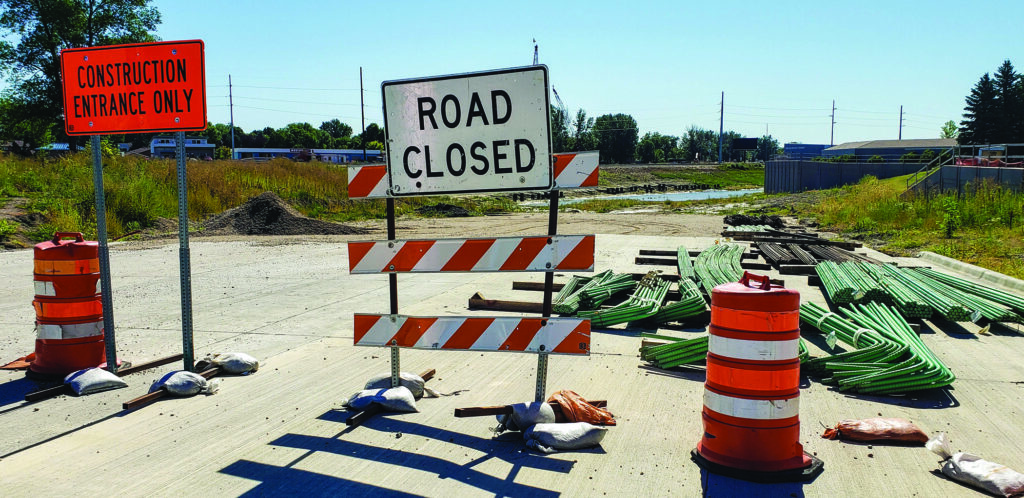
Southeast Main Avenue ends at the spot where the lanes will eventually dip down 30 feet below the upcoming railroad bridges. Photo/Nancy Hanson.
Nancy Edmonds Hanson
The long-awaited railroad underpass on Southeast Main Avenue, 20th and 21st Streets is going to keep drivers waiting even longer.
After running into problems with soil stability a year ago, crews working on the largest infrastructure project in Moorhead history are far behind the original construction schedule. When the city awarded the contract for straightening out the notorious tangle of streets and railroad tracks back in 2018, the envisioned completion state was set for Aug. 15, 2020.
Obviously that goal has come and gone, due to knotty problems that came to light as Ames Construction began to build the retaining walls that will support three railroad bridges over the four-lane vehicle underpass. Solving the geotechnical issues brought construction to a near-halt last summer … and has held up much of the progress anticipated this year. The latest prediction of when it may open to traffic is late 2021, with some elements of the project not due to be completed until mid-2022.
“Obviously the most critical factor is safety,” says assistant city engineer Tom Trowbridge, who has been overseeing the $51 million undertaking. “That’s one thing we all agree on. It is a complex project to begin with, and this has complicated it even more. Our soils are very challenging. It has taken a long time to figure out the best plan forward. We think we have it now.”
Last month, the construction firm began driving piles for permanent retaining walls. Those walls must be in place before the first two of three planned bridges can be put into place. They will carry BNSF and Otter Tail Valley trains toward the south at what’s now ground level, while cars and trucks pass 30 feet beneath on yet-to-be-built connections along Southeast Main (Highway 52), 20th and 21st Streets.
On June 1, the engineer’s office reported that 65% of the work had been completed. This week, Trowbridge estimates about 204,000 cubic yards has been excavated to date, or 70% of the goal. The project is at about 72% completion overall, including construction, track and signal work. The storm water pumping station that will drain the big dig is nearly done now.
“Some activities are sequential,” he says. “One thing must be completed before the next can be begun. They can’t do the bridges until the retaining walls are in place. We have to get to the permanent alignment of the Otter Tail Valley track before the BNSF work can be done.” The girders for the OTRR bridge may be moved into place sometime this fall. Only then can progress be made on the remaining BNSF bridges, as well as permanent tracks, storm sewers and roadways.
“There’s still a lot of uncertainty,” the engineer concedes. “One part of the project that can take awhile is driving the piling and shoring up the banks. When they pour the retaining walls and panels, only so much can be done a time. And there are a lot of retaining walls, at least 10. It’s even hard describing the challenges.”
Other elements, though, have moved as far forward as they can at this point. Roadway extensions have been completed up to the tie-in points where they’ll join lanes beneath the tracks. About 55,000 feet of structural support piling has been installed.
With school opening next week, traffic access is again a major concern. “We had some pretty rough times during the first days a year ago,” Trowbridge remembers. “But our traffic engineer and the school’s busing supervisor figured out how to handle the traffic flow, and that has worked out pretty well.” With the north end of 21st Street opened to Fourth Avenue South, the crunch was divided between that approach and the main detour via 34th Street.
It took 20 years of dreams, debates and lobbying to bring the SE Main/20/21st Street project to where it is today. Trowbridge says that it still stands as the single largest infrastructure project in the city’s history. “The cost of flood control is the only thing that’s been higher, at $110 million” he notes, “but that was accomplished through 70 separate contracts over 10 years.” He hints, though, that an even costlier undertaking may lie ahead: The price tag for the much-desired underpass beneath the busy BNSF tracks between First, Center and Main Avenues at 11th Street will almost certainly be higher.
In the meantime, despite the drama and delays of the present project, he predicts a happy ending: “When it’s done – whenever that is – it will be great, and we’ll all be very happy.”


